ACC707: Audit of Inventory and Intellectual Property Rights Assignment
VerifiedAdded on 2023/06/07
|13
|2776
|181
Homework Assignment
AI Summary
This audit assignment examines audit assertions related to inventory and intellectual property rights, crucial components of a company's balance sheet. The assignment begins with an executive summary and contents section, followed by a detailed discussion of audit assertions, emphasizing their role in ensuring the accuracy and transparency of financial statements. The first part focuses on inventory, analyzing key assertions at risk, such as valuation and rights & obligations, and outlining substantive audit procedures to mitigate these risks, including physical inventory counts, valuation at the lower of cost or net realizable value, and review of purchase records. It also addresses the implications of ASA 701, communicating key audit matters, particularly the valuation of inventory. The second part shifts to intellectual property rights, discussing valuation methods, rights and obligations, and relevant substantive audit procedures. The assignment highlights the complexities and potential risks associated with intellectual property, emphasizing the importance of legal documentation and ownership verification. The assignment concludes by reiterating the significance of ASA 701 in disclosing key audit matters, such as intellectual property valuation, to enhance transparency in the audit report. The assignment includes an analysis of the given case study of Computing Solutions Limited.
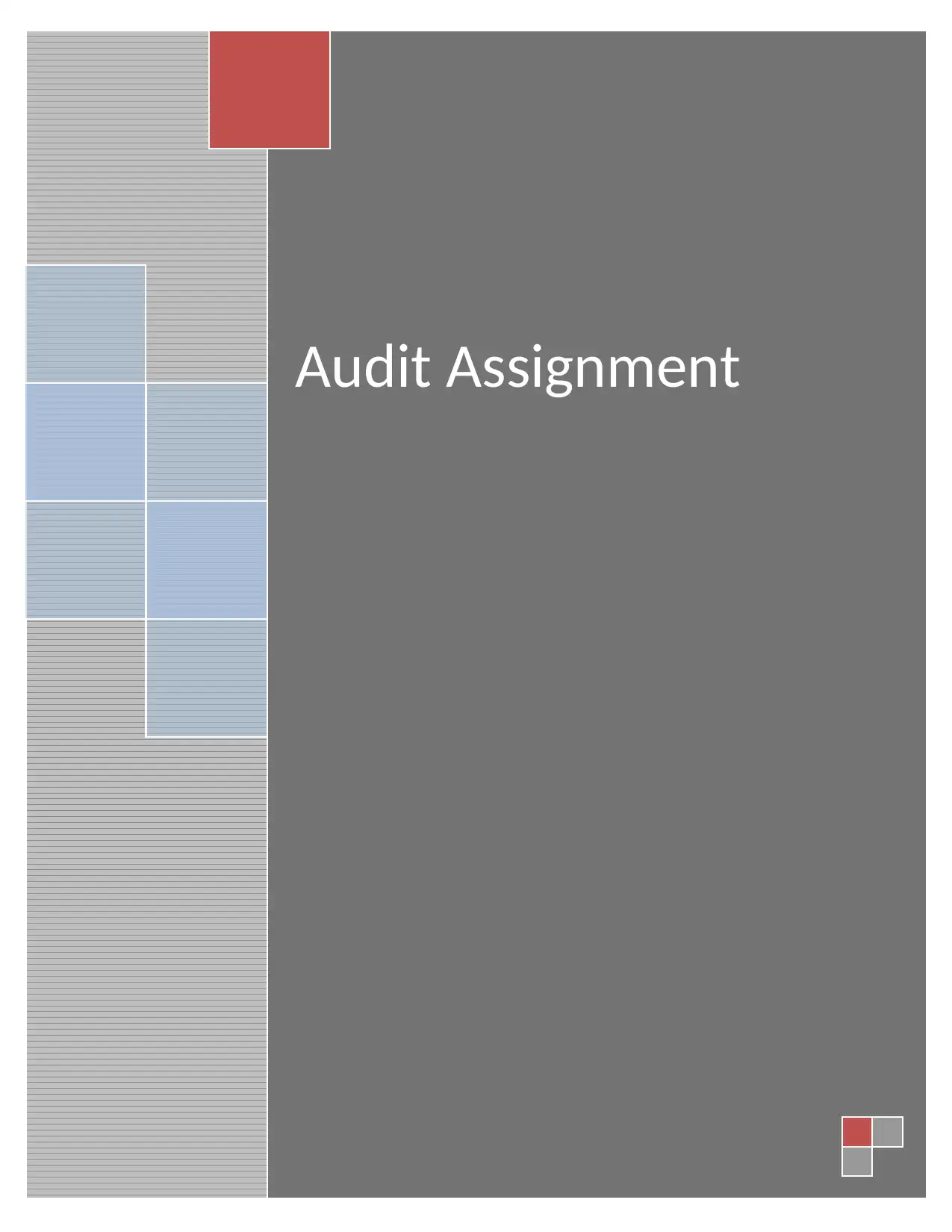
Audit Assignment
Paraphrase This Document
Need a fresh take? Get an instant paraphrase of this document with our AI Paraphraser

1
By student name
Professor
University
Date: 7th Sep 2018.
Executive Summary
1 | P a g e
By student name
Professor
University
Date: 7th Sep 2018.
Executive Summary
1 | P a g e
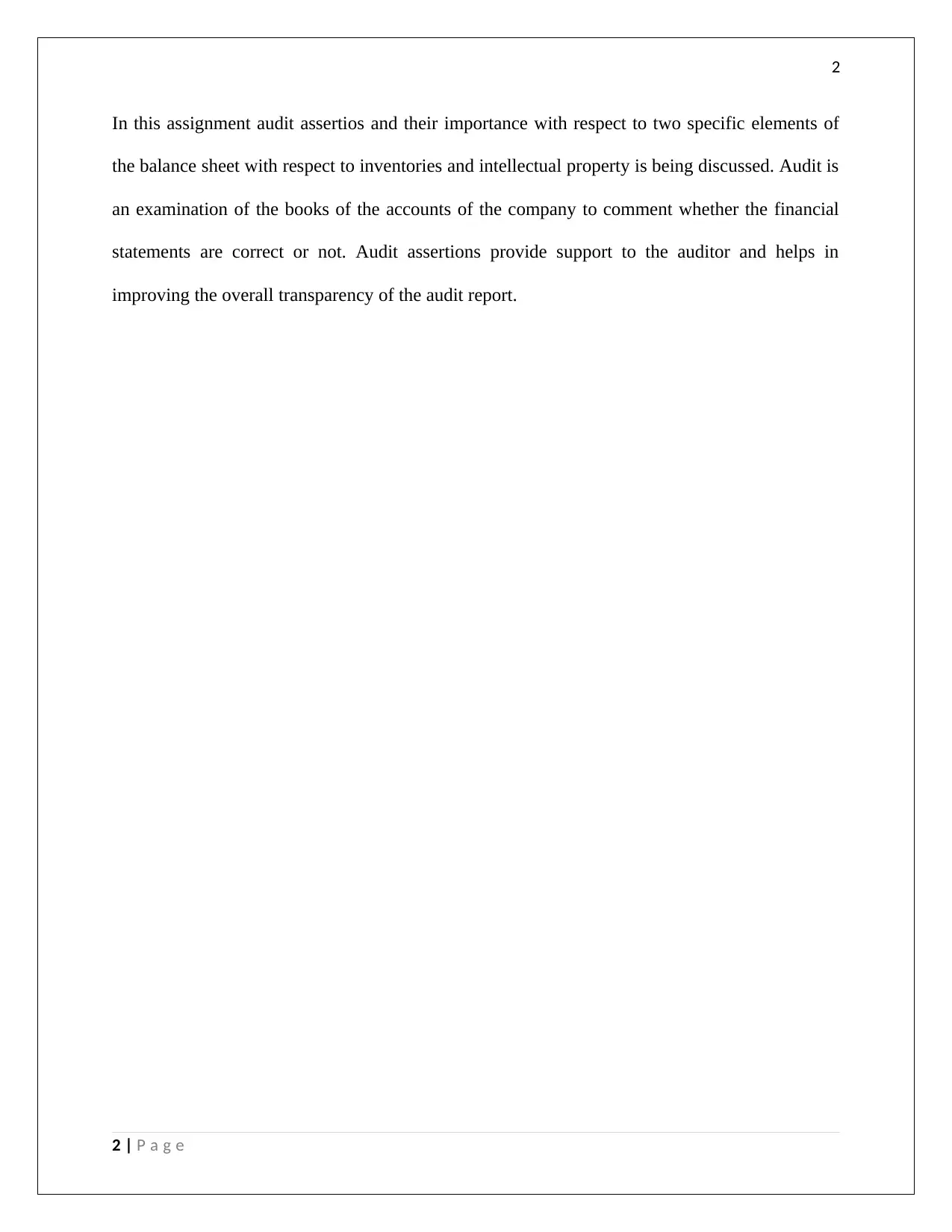
2
In this assignment audit assertios and their importance with respect to two specific elements of
the balance sheet with respect to inventories and intellectual property is being discussed. Audit is
an examination of the books of the accounts of the company to comment whether the financial
statements are correct or not. Audit assertions provide support to the auditor and helps in
improving the overall transparency of the audit report.
2 | P a g e
In this assignment audit assertios and their importance with respect to two specific elements of
the balance sheet with respect to inventories and intellectual property is being discussed. Audit is
an examination of the books of the accounts of the company to comment whether the financial
statements are correct or not. Audit assertions provide support to the auditor and helps in
improving the overall transparency of the audit report.
2 | P a g e
⊘ This is a preview!⊘
Do you want full access?
Subscribe today to unlock all pages.

Trusted by 1+ million students worldwide
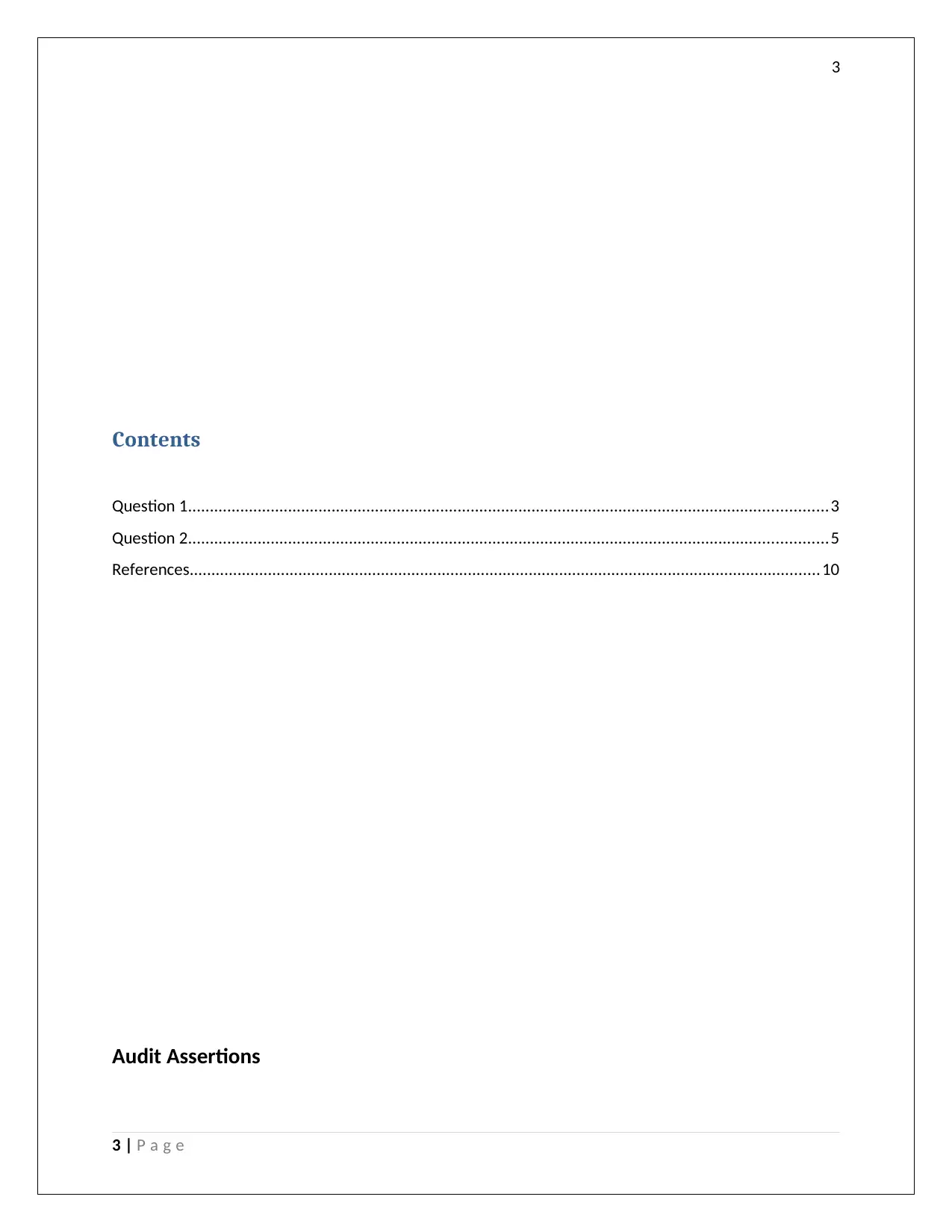
3
Contents
Question 1...................................................................................................................................................3
Question 2...................................................................................................................................................5
References.................................................................................................................................................10
Audit Assertions
3 | P a g e
Contents
Question 1...................................................................................................................................................3
Question 2...................................................................................................................................................5
References.................................................................................................................................................10
Audit Assertions
3 | P a g e
Paraphrase This Document
Need a fresh take? Get an instant paraphrase of this document with our AI Paraphraser

4
Assertion simply means a claim made by someone about something. The Audit Assertions are
claims and representation made implicitly or explicitly accountable for the preparation of the
financial statements and their transparency and viability.They are also referred to as the
Management and Financial Statement Assertions. The auditors rely upon a variety of assertions
made by the management regarding the business. There are different elements based on which
the assertions of the financial statements are tested and those include completeness,
appropriatness, accuracy, obligations etc.These assertions play a vital role in audit of the
financial statements as it helps the auditor in understanding various issues related to the
financial statements and also resolving the same.
1 a) Key Assertions at Risk
Valuation: Inventories are the major assets of the company and hence it is important
that they should be valued accordingly.According to the standards of accounting the
inventories are valued at the lower of cost or net realizable value. The values also
provide that surety must be obtained that no abnormal wastage has been included in
the valuation of inventory. It is provided in question that Computing Solutions Limited is
the seller of computer presentation package, so there are high chances that the
inventories are become obsolete (Das, 2017). In a fast growing world where the
technologies are upgrading on a daily basis, products are ought to get outdated within a
very short span of time, which results in impairment of their value rapidly.
4 | P a g e
Assertion simply means a claim made by someone about something. The Audit Assertions are
claims and representation made implicitly or explicitly accountable for the preparation of the
financial statements and their transparency and viability.They are also referred to as the
Management and Financial Statement Assertions. The auditors rely upon a variety of assertions
made by the management regarding the business. There are different elements based on which
the assertions of the financial statements are tested and those include completeness,
appropriatness, accuracy, obligations etc.These assertions play a vital role in audit of the
financial statements as it helps the auditor in understanding various issues related to the
financial statements and also resolving the same.
1 a) Key Assertions at Risk
Valuation: Inventories are the major assets of the company and hence it is important
that they should be valued accordingly.According to the standards of accounting the
inventories are valued at the lower of cost or net realizable value. The values also
provide that surety must be obtained that no abnormal wastage has been included in
the valuation of inventory. It is provided in question that Computing Solutions Limited is
the seller of computer presentation package, so there are high chances that the
inventories are become obsolete (Das, 2017). In a fast growing world where the
technologies are upgrading on a daily basis, products are ought to get outdated within a
very short span of time, which results in impairment of their value rapidly.
4 | P a g e

5
Rights and Obligations: The assertion of rights and obligations is a elementary assertion
that all the assets and liabilities included in a financial statement belongs to the
company delivering such financial statement. (Belton, 2017). The practice followed by
Computing Solution in regard to the inventories is that it moves the inventories from the
chief warehouse to six regional warehouses, which involves risk to rights and obligations
assertion. Since there are outside parties involved like consignee, when goods are on
consignment, insurance companies, transporter, when the goods are in transit. So, the
risk is high in relation to this assertion, hence, the clear understanding of rights and
obligation assertion is very significant in this case.
1 b) Substantive Audit Procedures: The activities which are done by the auditors to notice the
material misstatement or fraud at the assertion level are known as substantive audit
procedures. For valuation risk: In case of inventory, the auditor is required to observe the
physical count of the inventory, which should be done periodically. The auditor should analyze
the procedures used for inventory count by discussing the counting procedures and observe the
count as the same is being done. In case of multiple inventory storage locations, the auditor
should test the inventory in those locations where the amount of inventory is noteworthy and
also ask for confirmations of inventory from the guardian of the warehouse. The auditor should
reconcile the inventory count to the general ledger and also do physical inventory count to
those of general ledger (Kim, et al., 2017). In case there are items in the inventory the value of
which is unusually high, then the auditor is likely to ensure that they are valued correctly by
investing more time in the physical count of such inventory. The inventory must be valued at
5 | P a g e
Rights and Obligations: The assertion of rights and obligations is a elementary assertion
that all the assets and liabilities included in a financial statement belongs to the
company delivering such financial statement. (Belton, 2017). The practice followed by
Computing Solution in regard to the inventories is that it moves the inventories from the
chief warehouse to six regional warehouses, which involves risk to rights and obligations
assertion. Since there are outside parties involved like consignee, when goods are on
consignment, insurance companies, transporter, when the goods are in transit. So, the
risk is high in relation to this assertion, hence, the clear understanding of rights and
obligation assertion is very significant in this case.
1 b) Substantive Audit Procedures: The activities which are done by the auditors to notice the
material misstatement or fraud at the assertion level are known as substantive audit
procedures. For valuation risk: In case of inventory, the auditor is required to observe the
physical count of the inventory, which should be done periodically. The auditor should analyze
the procedures used for inventory count by discussing the counting procedures and observe the
count as the same is being done. In case of multiple inventory storage locations, the auditor
should test the inventory in those locations where the amount of inventory is noteworthy and
also ask for confirmations of inventory from the guardian of the warehouse. The auditor should
reconcile the inventory count to the general ledger and also do physical inventory count to
those of general ledger (Kim, et al., 2017). In case there are items in the inventory the value of
which is unusually high, then the auditor is likely to ensure that they are valued correctly by
investing more time in the physical count of such inventory. The inventory must be valued at
5 | P a g e
⊘ This is a preview!⊘
Do you want full access?
Subscribe today to unlock all pages.

Trusted by 1+ million students worldwide

6
the lower of cost or net realizable value, the auditor is required to ensure the same by
comparing a selection of inventory’s net realizable value with their recorded cost. The review of
the closing stock should be done by the auditor with more diligence as it is valued at the closing
date and risk of inflation or deflation is high in such case.
For rights and obligations: The auditor should review the purchase records to ensure
the ownership rights of the inventories that are stored in the warehouse lies with the company
and not with the suppliers or the assigners. In case of inventory that is on consignment, the
auditor should review the consignment agreement to verify the ownership rights, also in case of
insurance, the auditor should review the insurance policy (Jefferson, 2017). Basically wherever
there is involvement of third parties the auditor should check the corresponding legal
documents like agreements, to verify the ownership rights, as the risk involved in such cases are
high.
1 c) The Auditing Standard ASA 701, Communicating Key Audit Matters in the
Independent Auditors Report, was issued by AUSB pursuant to the disclosure requirements of
the key audit matters by the auditors in the audit report. The main purpose of disclosing
requirements of the key audit matters by the auditors is to bring more transparency and more
insight to the audit report of a financial statement. As per ASA 701, the auditors are required to
identify the key audit matters that require significant audit attention; these are required to be
disclosed as a separate heading, clearly stating the reasons for determining the matters as key
audit matters, their significance in audit along with related risk (Grenier, 2017). The auditor is to
mention in detail the substantive audit procedures and substantive analytical procedures
6 | P a g e
the lower of cost or net realizable value, the auditor is required to ensure the same by
comparing a selection of inventory’s net realizable value with their recorded cost. The review of
the closing stock should be done by the auditor with more diligence as it is valued at the closing
date and risk of inflation or deflation is high in such case.
For rights and obligations: The auditor should review the purchase records to ensure
the ownership rights of the inventories that are stored in the warehouse lies with the company
and not with the suppliers or the assigners. In case of inventory that is on consignment, the
auditor should review the consignment agreement to verify the ownership rights, also in case of
insurance, the auditor should review the insurance policy (Jefferson, 2017). Basically wherever
there is involvement of third parties the auditor should check the corresponding legal
documents like agreements, to verify the ownership rights, as the risk involved in such cases are
high.
1 c) The Auditing Standard ASA 701, Communicating Key Audit Matters in the
Independent Auditors Report, was issued by AUSB pursuant to the disclosure requirements of
the key audit matters by the auditors in the audit report. The main purpose of disclosing
requirements of the key audit matters by the auditors is to bring more transparency and more
insight to the audit report of a financial statement. As per ASA 701, the auditors are required to
identify the key audit matters that require significant audit attention; these are required to be
disclosed as a separate heading, clearly stating the reasons for determining the matters as key
audit matters, their significance in audit along with related risk (Grenier, 2017). The auditor is to
mention in detail the substantive audit procedures and substantive analytical procedures
6 | P a g e
Paraphrase This Document
Need a fresh take? Get an instant paraphrase of this document with our AI Paraphraser

7
followed by the auditor in the audit of such key audit matters. The auditor is required to state
such details in simple language avoiding the use of very technical terms in order to make the
shareholder understand, since mpost people are not accustomed to technical auditing terms
(Goldmann, 2016).
The valuation of inventory can be considered as a key audit matter since the level of
complexity involved is high. The valuation and recording of inventory requires a lot of prudence
on the part of the management (Sithole, et al., 2017).
The disclosure required in relation to key audit matters, as per ASA 701 are:
The auditor should first describe the key audit matter with the help of a suitable heading in a
separate section of the audit report under “Key Audit Matters”. The auditor should describe the
key audit matters in reference to the related disclosures in the financial statements and state
what are the audit procedures that have been undertaken by the auditor of the company. The
auditor should clearly mention his observation on such matters in the audit report.
In case where the auditor, based on the circumstances and facts of the audit of any
entity, considers that there are no key audit matters , a statement should be provided by the
auditor separately, in a section to this effect under “Key Audit Matters”.
2) Intellectual property rights are legal rights that protect the creation or innovation of
new ideas by people or company. These are intangible assets like, patents, copyrights,
trademarks. The intellectual property rights became a commonplace in the majority of the
world in the 20th century (Trieu, 2017). With growing technologies and more innovative ideas
7 | P a g e
followed by the auditor in the audit of such key audit matters. The auditor is required to state
such details in simple language avoiding the use of very technical terms in order to make the
shareholder understand, since mpost people are not accustomed to technical auditing terms
(Goldmann, 2016).
The valuation of inventory can be considered as a key audit matter since the level of
complexity involved is high. The valuation and recording of inventory requires a lot of prudence
on the part of the management (Sithole, et al., 2017).
The disclosure required in relation to key audit matters, as per ASA 701 are:
The auditor should first describe the key audit matter with the help of a suitable heading in a
separate section of the audit report under “Key Audit Matters”. The auditor should describe the
key audit matters in reference to the related disclosures in the financial statements and state
what are the audit procedures that have been undertaken by the auditor of the company. The
auditor should clearly mention his observation on such matters in the audit report.
In case where the auditor, based on the circumstances and facts of the audit of any
entity, considers that there are no key audit matters , a statement should be provided by the
auditor separately, in a section to this effect under “Key Audit Matters”.
2) Intellectual property rights are legal rights that protect the creation or innovation of
new ideas by people or company. These are intangible assets like, patents, copyrights,
trademarks. The intellectual property rights became a commonplace in the majority of the
world in the 20th century (Trieu, 2017). With growing technologies and more innovative ideas
7 | P a g e
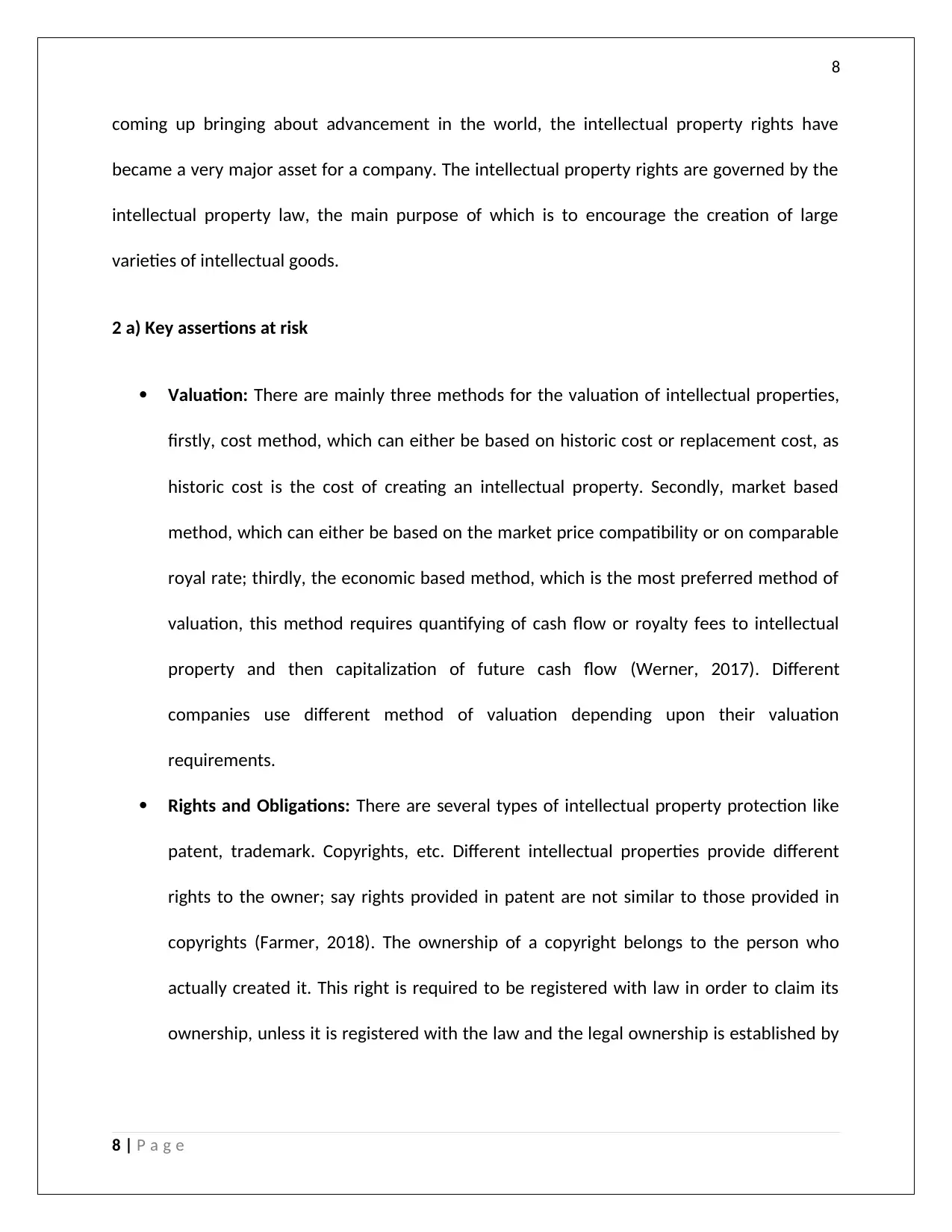
8
coming up bringing about advancement in the world, the intellectual property rights have
became a very major asset for a company. The intellectual property rights are governed by the
intellectual property law, the main purpose of which is to encourage the creation of large
varieties of intellectual goods.
2 a) Key assertions at risk
Valuation: There are mainly three methods for the valuation of intellectual properties,
firstly, cost method, which can either be based on historic cost or replacement cost, as
historic cost is the cost of creating an intellectual property. Secondly, market based
method, which can either be based on the market price compatibility or on comparable
royal rate; thirdly, the economic based method, which is the most preferred method of
valuation, this method requires quantifying of cash flow or royalty fees to intellectual
property and then capitalization of future cash flow (Werner, 2017). Different
companies use different method of valuation depending upon their valuation
requirements.
Rights and Obligations: There are several types of intellectual property protection like
patent, trademark. Copyrights, etc. Different intellectual properties provide different
rights to the owner; say rights provided in patent are not similar to those provided in
copyrights (Farmer, 2018). The ownership of a copyright belongs to the person who
actually created it. This right is required to be registered with law in order to claim its
ownership, unless it is registered with the law and the legal ownership is established by
8 | P a g e
coming up bringing about advancement in the world, the intellectual property rights have
became a very major asset for a company. The intellectual property rights are governed by the
intellectual property law, the main purpose of which is to encourage the creation of large
varieties of intellectual goods.
2 a) Key assertions at risk
Valuation: There are mainly three methods for the valuation of intellectual properties,
firstly, cost method, which can either be based on historic cost or replacement cost, as
historic cost is the cost of creating an intellectual property. Secondly, market based
method, which can either be based on the market price compatibility or on comparable
royal rate; thirdly, the economic based method, which is the most preferred method of
valuation, this method requires quantifying of cash flow or royalty fees to intellectual
property and then capitalization of future cash flow (Werner, 2017). Different
companies use different method of valuation depending upon their valuation
requirements.
Rights and Obligations: There are several types of intellectual property protection like
patent, trademark. Copyrights, etc. Different intellectual properties provide different
rights to the owner; say rights provided in patent are not similar to those provided in
copyrights (Farmer, 2018). The ownership of a copyright belongs to the person who
actually created it. This right is required to be registered with law in order to claim its
ownership, unless it is registered with the law and the legal ownership is established by
8 | P a g e
⊘ This is a preview!⊘
Do you want full access?
Subscribe today to unlock all pages.

Trusted by 1+ million students worldwide

9
the law, the intellectual property rights cannot be recognized in the books as assets.
There are complexities involved in such rights, creating greater risk on assertions.
2 b) Substantive audit procedures: Substantive audit procedures refer to the collection of
data by the auditor during the audit process for audit evidences. Substantive audit procedures
help the auditor in confirming that there are no material misstatements in the financial
statements and that the financial statements are free from any material discrepancies . (Erik &
Jan, 2017). The general categories of activity included in substantive audit procedures are:
Testing the various classes of transactions, account balances and disclosures;
Examining the various journal entries, assumptions and adjustments made during the
preparation of the financial statements
Verifying that the financial statements and the notes accompanying thereto are in
agreement to the underlying accounting records.
In case of intangible assets the substantive audit procedures involves that the intangible
asset exists by reviewing appropriate documentation like legal documents; determining the
ownership rights of the intangible assets belongs to the company and where acquired, the
auditor should check the purchase agreement; the auditor should assess the useful life of the
intangible asset, which if finite, then amortization policy and amortization expense should be
reviewed; the management should be inquired in regard to the carrying amount of the
intangible asset, whether recoverable (Choy, 2018).
9 | P a g e
the law, the intellectual property rights cannot be recognized in the books as assets.
There are complexities involved in such rights, creating greater risk on assertions.
2 b) Substantive audit procedures: Substantive audit procedures refer to the collection of
data by the auditor during the audit process for audit evidences. Substantive audit procedures
help the auditor in confirming that there are no material misstatements in the financial
statements and that the financial statements are free from any material discrepancies . (Erik &
Jan, 2017). The general categories of activity included in substantive audit procedures are:
Testing the various classes of transactions, account balances and disclosures;
Examining the various journal entries, assumptions and adjustments made during the
preparation of the financial statements
Verifying that the financial statements and the notes accompanying thereto are in
agreement to the underlying accounting records.
In case of intangible assets the substantive audit procedures involves that the intangible
asset exists by reviewing appropriate documentation like legal documents; determining the
ownership rights of the intangible assets belongs to the company and where acquired, the
auditor should check the purchase agreement; the auditor should assess the useful life of the
intangible asset, which if finite, then amortization policy and amortization expense should be
reviewed; the management should be inquired in regard to the carrying amount of the
intangible asset, whether recoverable (Choy, 2018).
9 | P a g e
Paraphrase This Document
Need a fresh take? Get an instant paraphrase of this document with our AI Paraphraser
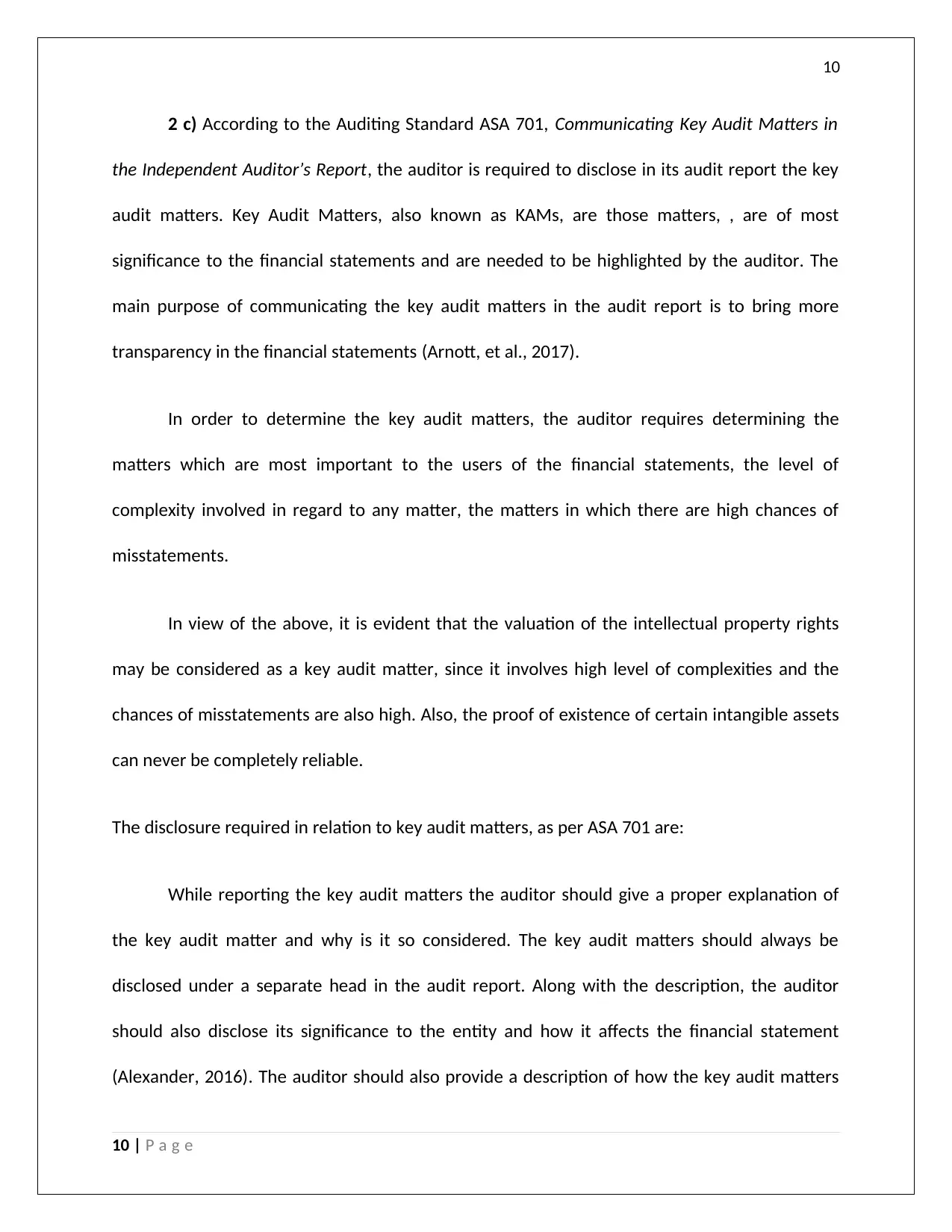
10
2 c) According to the Auditing Standard ASA 701, Communicating Key Audit Matters in
the Independent Auditor’s Report, the auditor is required to disclose in its audit report the key
audit matters. Key Audit Matters, also known as KAMs, are those matters, , are of most
significance to the financial statements and are needed to be highlighted by the auditor. The
main purpose of communicating the key audit matters in the audit report is to bring more
transparency in the financial statements (Arnott, et al., 2017).
In order to determine the key audit matters, the auditor requires determining the
matters which are most important to the users of the financial statements, the level of
complexity involved in regard to any matter, the matters in which there are high chances of
misstatements.
In view of the above, it is evident that the valuation of the intellectual property rights
may be considered as a key audit matter, since it involves high level of complexities and the
chances of misstatements are also high. Also, the proof of existence of certain intangible assets
can never be completely reliable.
The disclosure required in relation to key audit matters, as per ASA 701 are:
While reporting the key audit matters the auditor should give a proper explanation of
the key audit matter and why is it so considered. The key audit matters should always be
disclosed under a separate head in the audit report. Along with the description, the auditor
should also disclose its significance to the entity and how it affects the financial statement
(Alexander, 2016). The auditor should also provide a description of how the key audit matters
10 | P a g e
2 c) According to the Auditing Standard ASA 701, Communicating Key Audit Matters in
the Independent Auditor’s Report, the auditor is required to disclose in its audit report the key
audit matters. Key Audit Matters, also known as KAMs, are those matters, , are of most
significance to the financial statements and are needed to be highlighted by the auditor. The
main purpose of communicating the key audit matters in the audit report is to bring more
transparency in the financial statements (Arnott, et al., 2017).
In order to determine the key audit matters, the auditor requires determining the
matters which are most important to the users of the financial statements, the level of
complexity involved in regard to any matter, the matters in which there are high chances of
misstatements.
In view of the above, it is evident that the valuation of the intellectual property rights
may be considered as a key audit matter, since it involves high level of complexities and the
chances of misstatements are also high. Also, the proof of existence of certain intangible assets
can never be completely reliable.
The disclosure required in relation to key audit matters, as per ASA 701 are:
While reporting the key audit matters the auditor should give a proper explanation of
the key audit matter and why is it so considered. The key audit matters should always be
disclosed under a separate head in the audit report. Along with the description, the auditor
should also disclose its significance to the entity and how it affects the financial statement
(Alexander, 2016). The auditor should also provide a description of how the key audit matters
10 | P a g e
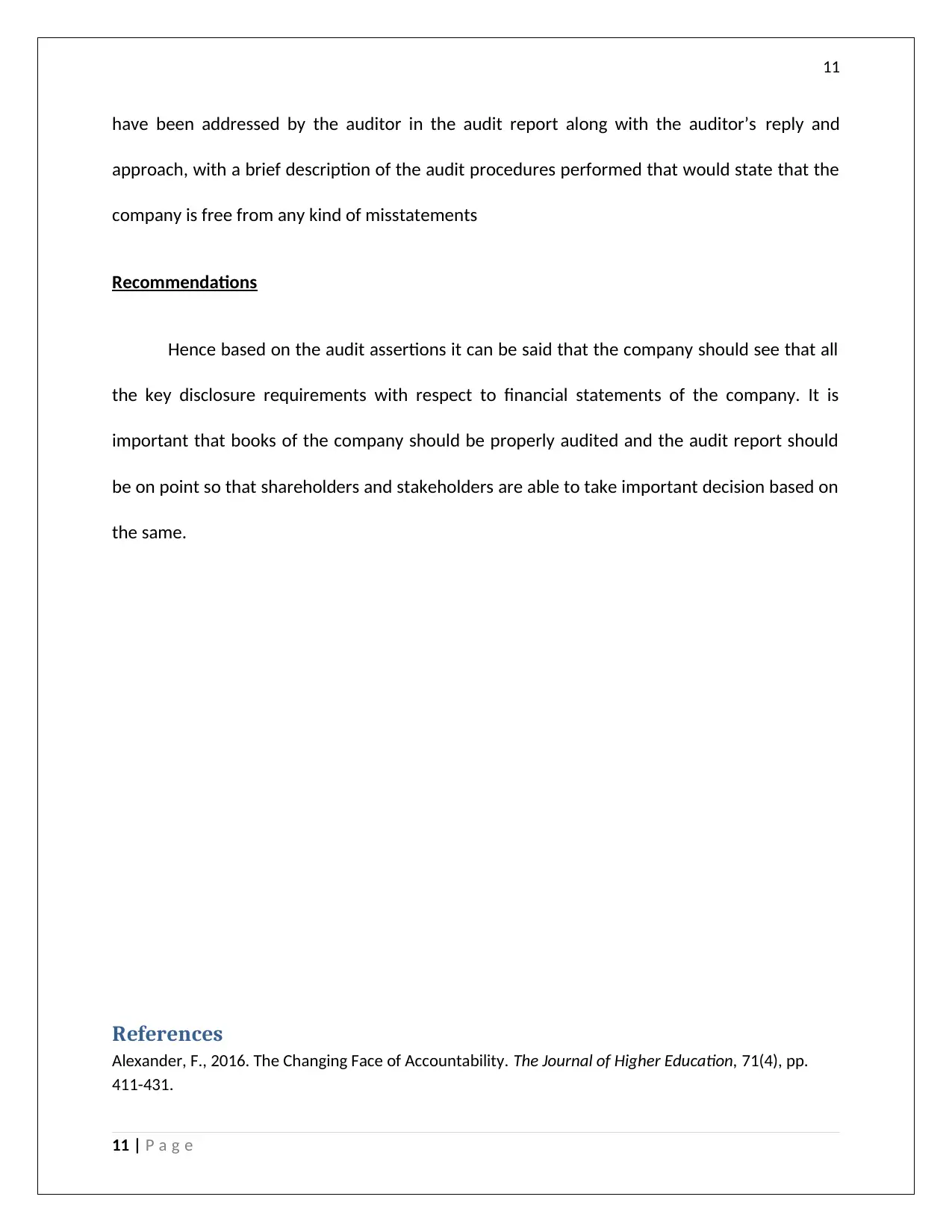
11
have been addressed by the auditor in the audit report along with the auditor’s reply and
approach, with a brief description of the audit procedures performed that would state that the
company is free from any kind of misstatements
Recommendations
Hence based on the audit assertions it can be said that the company should see that all
the key disclosure requirements with respect to financial statements of the company. It is
important that books of the company should be properly audited and the audit report should
be on point so that shareholders and stakeholders are able to take important decision based on
the same.
References
Alexander, F., 2016. The Changing Face of Accountability. The Journal of Higher Education, 71(4), pp.
411-431.
11 | P a g e
have been addressed by the auditor in the audit report along with the auditor’s reply and
approach, with a brief description of the audit procedures performed that would state that the
company is free from any kind of misstatements
Recommendations
Hence based on the audit assertions it can be said that the company should see that all
the key disclosure requirements with respect to financial statements of the company. It is
important that books of the company should be properly audited and the audit report should
be on point so that shareholders and stakeholders are able to take important decision based on
the same.
References
Alexander, F., 2016. The Changing Face of Accountability. The Journal of Higher Education, 71(4), pp.
411-431.
11 | P a g e
⊘ This is a preview!⊘
Do you want full access?
Subscribe today to unlock all pages.

Trusted by 1+ million students worldwide
1 out of 13
Related Documents
Your All-in-One AI-Powered Toolkit for Academic Success.
+13062052269
info@desklib.com
Available 24*7 on WhatsApp / Email
![[object Object]](/_next/static/media/star-bottom.7253800d.svg)
Unlock your academic potential
Copyright © 2020–2025 A2Z Services. All Rights Reserved. Developed and managed by ZUCOL.





